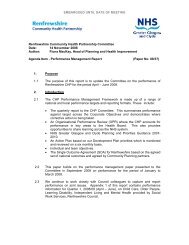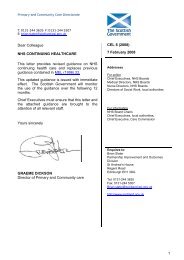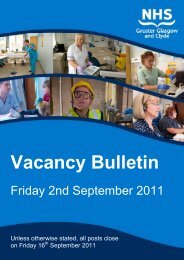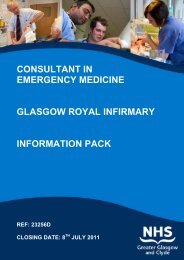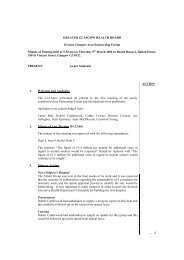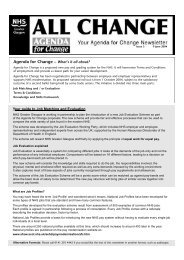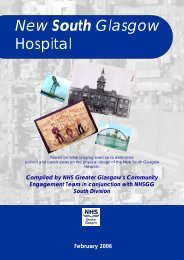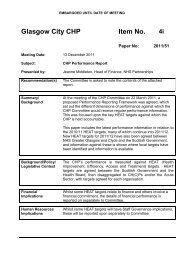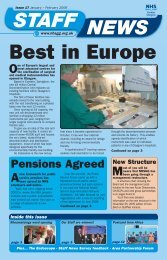nhsggc(m)09/3 - NHS Greater Glasgow and Clyde
nhsggc(m)09/3 - NHS Greater Glasgow and Clyde
nhsggc(m)09/3 - NHS Greater Glasgow and Clyde
Create successful ePaper yourself
Turn your PDF publications into a flip-book with our unique Google optimized e-Paper software.
EMBARGOED UNTIL 23 JUNE 20<strong>09</strong> BOARD MEETING<br />
Dr Cowan explained that the monitoring report was required by the National HAI<br />
Task Force Action Plan <strong>and</strong> presented data on the performance of <strong>NHS</strong> <strong>Greater</strong><br />
<strong>Glasgow</strong> & <strong>Clyde</strong> on a range of key HAI indicators at national <strong>and</strong> individual<br />
hospital site level.<br />
ACTION BY<br />
Dr Cowan led the <strong>NHS</strong> Board through the data highlighting the following points:-<br />
• If current trends were maintained, <strong>NHS</strong>GGC was on target to achieve the<br />
35% reduction in S.aureus bacteraemia by 2010. This replicated the<br />
national trend for <strong>NHS</strong> Scotl<strong>and</strong>. All Statistical Process Charts (SPCs)<br />
for Methicillin-Resistant Staphylococcus Aureus (MRSA) (all types of<br />
MRSA not only blood stream infection) at hospital level were within<br />
control limits.<br />
• The national report published on 14 January 20<strong>09</strong> showed a reduction in<br />
the rate of C.Difficile within <strong>NHS</strong>GGC <strong>and</strong> placed the <strong>NHS</strong> Board below<br />
the national mean. In 2007/2008, the annual overall rate for <strong>NHS</strong><br />
Scotl<strong>and</strong> per 1000 occupied bed days was 1.29. The rate for <strong>NHS</strong>GGC<br />
was below that <strong>and</strong> was reported as 1.08 for the same period.<br />
• <strong>NHS</strong>GGC had decreasing rates of C.Diff infection during the last 3<br />
quarters of national reporting (January 2008 – September 2008). All<br />
SPCs for C.Diff at hospital site level were within control limits.<br />
• In terms of h<strong>and</strong> hygiene <strong>and</strong> the <strong>NHS</strong> Board’s zero tolerance approach<br />
to non compliance, <strong>NHS</strong>GGC had demonstrated a steady rise in<br />
compliance from a 62% baseline in February 2007. The most recent<br />
national report published in March 20<strong>09</strong> showed a maintained figure of<br />
92%. Dr Cowan recorded that local audits were taking place across<br />
<strong>NHS</strong>GGC. These involved ward staff monitoring their own compliance.<br />
This had been facilitated by the training sessions carried out in<br />
conjunction with clinical risk management <strong>and</strong> infection control teams.<br />
Local monitoring was designed to enable senior charge nurses to identify<br />
<strong>and</strong> approach issues that may affect the compliance score. Dr Cowan<br />
noted that compliance amongst medical staff increased from 69% to 73%<br />
from the last audit period reported.<br />
• SPCs illustrated calculations based upon the ward/unit’s historical<br />
infection rate to produce 3 lines; the upper control limit, the lower<br />
control limit <strong>and</strong> the centre line (mean). The setting of the upper control<br />
limit allowed local teams to trigger action promptly in response to any<br />
increase in the number of patients identified. Although SPCs were a<br />
method of viewing what was going on at a local level, they could also be<br />
used to drive improvements in care. This was shown by reducing the<br />
mean (centre line) which indicated that less patients were acquiring<br />
infection in wards <strong>and</strong> hospitals. Now that SPCs were available across<br />
the whole of <strong>NHS</strong>GGC, improvements would be actively targeted in<br />
areas with historically high levels of infection <strong>and</strong> sustaining<br />
improvements in areas with low infection rate.<br />
• Across <strong>NHS</strong>GGC during the reporting period, many of the Board’s<br />
hospitals had shown a reduction in their top upper limit which meant that<br />
an improvement trajectory had been created. This was the case after<br />
reporting 8 consecutive targets being met <strong>and</strong> was received by the<br />
Board’s Infection Control Manager.<br />
4




